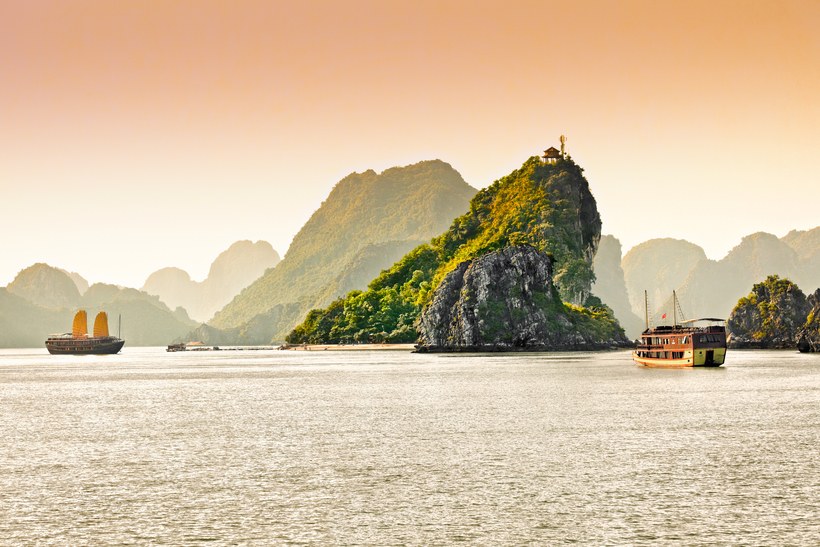
Halong Bay, Vietnam
Halong Bay, located in northeast Vietnam, is beloved for its blue waters and spread of limestone islands, all occupied by tropical trees and wildlife. Board a Chinese junk boat to experience the beauty”and associated myths and stories”of the mist-shrouded emerald basin for yourself.
Location
Ha Long Bay is located in northeastern Vietnam, from E106°55' to E107°37' and from N20°43' to N21°09'. The bay stretches from Quang Yen town, past Ha Long city, Cam Pha city town to Van Don district, bordered on the south and southeast by Lan Ha Bay, on the north by Ha Long city, and on the west by Bai Tu Long Bay. The bay has a 120-kilometre-long (75 mi) coastline and is approximately 1,553 km2 (600 sq mi) in size with about 2,000 islets. The area designated by UNESCO as the World Natural Heritage Site incorporates 434 km2 (168 sq mi) with 775 islets, of which the core zone is delimited by 69 points: Dau Go island on the west, Ba Ham lake on the south and Cong Tay island on the east. The protected area is from the Cai Dam petrol store to Quang Hanh ward, Cam Pha city and the surrounding zone.
Climate
The climate of the bay is tropical, wet, sea islands, with two seasons: hot and moist summer, and dry and cold winter. The average temperature is from 15-25
°C (59-77°F), and annual rainfall is between 2 and 2.2 metres (6.6 and 7.2 ft). Ha Long Bay has the typical diurnal tide system (tide amplitude ranges from 3.5
to4 metres or 11 to13 feet). The salinity is from 31 to 34.5MT in the dry season and lower in the rainy season.
Population
Of the 1,969 islands in Ha Long, only approximately 40 are inhabited. These islands range from tens to thousands of hectares in size, mainly in the East and Southeast of Ha Long Bay. In recent decades, thousands of villagers have been starting to settle down on the pristine islands and build new communities such as Sa To Island (Ha Long City), Thang Loi Island (Van
Eon district).
The population of Ha Long Bay is about 1,540, mainly in Cua Van, Ba Hang and Cap De fishing villages (Hung Thang Ward, Ha Long City). Residents of the bay mostly live on boats and rafts buoyed by tires and plastic jugs to facilitate the fishing, cultivating and breeding of aquatic and marine species. Fish require feeding every other day for up to three years, when they are eventually sold to local seafood restaurants for up to 300,000 Vietnamese dong per kilogram. Today the life of Ha Long Bay inhabitants has much improved due to new travel businesses. Residents of the floating villages around the Ha Long bay now offer bedrooms for rent, boat tours, and fresh seafood meals to tourists. While this is an isolating, back-breaking lifestyle, floating village residents are considered wealthy to residents of other Ha Long Bay islands. At present, the Quang Ninh provincial government has a policy to relocate the households living in the bay to resettle, in order to stabilize their life and to protect the landscape of the heritage zone. More than 300 households living in fishing villages in Ha Long Bay have been relocated ashore in Khe Ca Resettlement Area, now known as Zone 8 (Ha Phong Ward, Ha Long City) since May 2014. This project will continue to be implemented. The province will only retain a number of fishing villages for sightseeing tours.